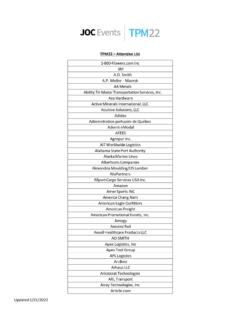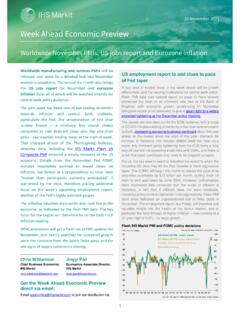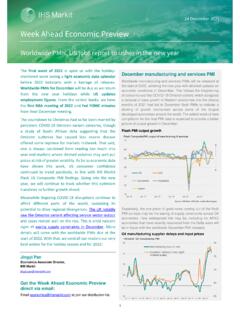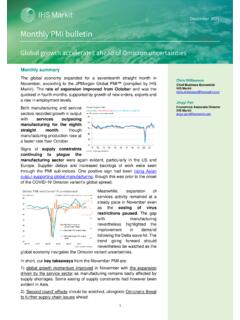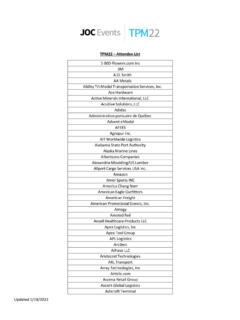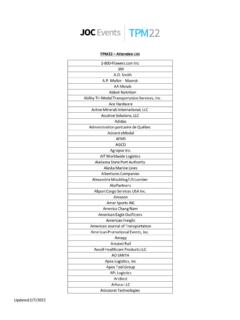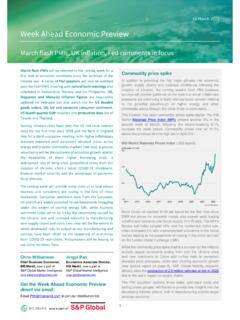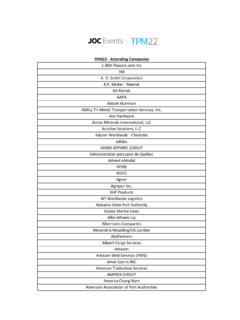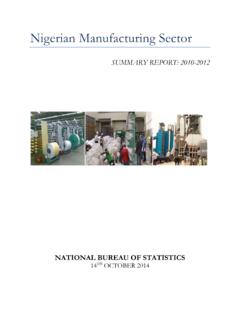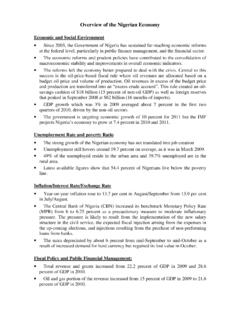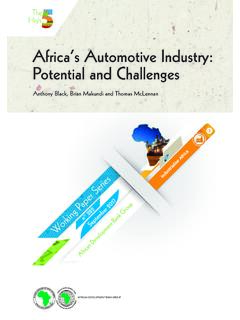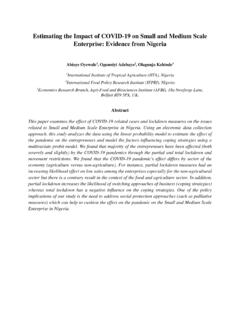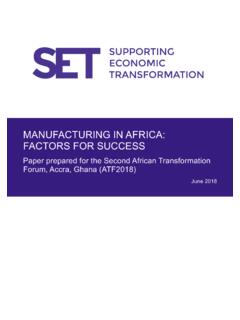Transcription of Monthly PMI bulletin
1 March 2022. Monthly PMI bulletin Global growth recovers, price pressures persist prior to Ukraine crisis Monthly summary The global economy expanded for a twentieth straight month* in February, Chris Williamson according to the JPMorgan Global PMI (compiled by IHS Markit), with the rate Chief Business Economist of expansion accelerating from January's 18-month low as the COVID-19 IHS Markit, now a part of Omicron wave showed signs of easing. S&P Global Market Intelligence Both manufacturing and services growth improved in February.
2 Jingyi Pan Services led the rebound with the Economics Associate Director strongest overall rate of expansion IHS Markit, now a part of S&P Global Market Intelligence being in businesses services, followed by consumer services. Developed world output growth surpassed that of emerging markets, once again underpinned by services activity expansion. Fewer restrictions across Western economies such as the US, UK and eurozone supported the recovery in developed market output growth. On manufacturing performance, global manufacturing growth picked up from the one-and-a-half year low in January although the overall rate of expansion continued to be constrained by supply chain delays and manpower shortages.
3 Prior to the eruption of the Ukraine crisis in late February, the PMI data also reflected persistent inflationary pressures faced by firms. These pressures may well be exacerbated by the latest Ukraine crisis through multiple channels such as upon energy prices, supply chain disruptions, the building of safety stocks and confidence which we will be closely watching with the March PMI figures. In short, our key takeaways from the February PMI are: 1) global growth proved resilient in the face of the latest COVID-19 Omicron wave, rebounding in February as cases receded and led by services 2) disruptions towards materials and staffs have persisted ahead of the Ukraine crisis, and further aggravation of the pressures should not be ruled out, potentially weighing on global output henceforth.
4 * Please note that due to later-than-usual release dates, February manufacturing data for Brazil, India and South Korea and services data for Brazil and India were not available for inclusion in the global numbers. Regional comparisons IHS Markit omposite utput Inde no change from prior month eb Jan Source IHS Markit au Jibun bank ai in IPS JPMorgan The Good, the Bad and the Ugly Key PMI developments The Good: Rebound underway as Omicron wave recedes The COVID-19 Omicron wave, that had hit particularly hard upon Western economies, showed signs of a turnaround on a global scale in February.
5 Consequently, the global economic expansion revived from January's one-and-a-half year low. To a large extent, the recovery had been led by services and the developed world in February. The UK saw the sharpest rate of growth while the US followed closely. Meanwhile manufacturing output in Asia excluding Japan and China also accelerated, reflecting resilient performance despite elevated COVID-19 cases in many constituent countries to bode well for Asian supply chain resilience in the face of the Omicron wave. [Link].
6 Confidential | Copyright 2022 IHS Markit Ltd Page 2 of 10. The Bad: Production constraints persist for manufacturers Despite some easing of supplier delays, primarily in the West, manufacturing output continued to lag demand growth at a severe rate, pointing to ongoing capacity constraints. Output was constrained by staff and material shortages, according to anecdotal reporting by PMI survey respondents. Concerns over raw material availability drove further safety stock building. [Link]. The Ugly: Elevated price pressures may worsen Price pressures worsened for manufacturers in February even as supply constraints showed signs of peaking.
7 Input prices rose at a faster rate amid shortages of many key raw materials and manufactured inputs such as semiconductors. More concerning for firms going forward is the rise in energy costs, which already played a part in pushing up input costs in February. Amid the prolongment of the Ukraine crisis into March and the surge in energy costs, the manufacturing economy in particular is expected to face higher cost pressures in the months ahead. Higher cost pressures have likewise been seen seeping into the services economy, placing central bankers in a tight spot between rising prices and expectations of lower output growth ahead.
8 Confidential | Copyright 2022 IHS Markit Ltd Page 3 of 10. Global PMI heatmap manufacturing manufacturing indices Output*. New orders*. New export orders Backlogs of work Employment*. Input prices Output prices Future expectations Quantity of purchases Suppliers' delivery times*. Stocks of purchases*. Stocks of finished goods *PMI components Services indices Business activity New business New export orders Outstanding business Employment Input costs Prices charged Future expectations Read more about the headline PMI and its subindices here.
9 Source: IHS Markit and relevant sponsors Key: Services Improving at a faster rate 2. Improving at a slower rate 1. At neutral mark 0. Deteriorating at a slower rate -1. Deteriorating at a faster rate -2. Improving Faster Slower rate of rate of improvement improvement 50. Faster rate of Slower deterioration rate of deterioration Source: IHS Markit and relevant sponsors Deteriorating To receive underlying PMI data, please contact: Confidential | Copyright 2022 IHS Markit Ltd Page 4 of 10. Composite / Whole Economy Composite indices Output/business activity New business New export orders Outstanding business Employment Input costs Output prices Future expectations Read more about the headline PMI and its subindices here.
10 Key: Improving at a faster rate 2. Improving at a slower rate 1. At neutral mark 0. Deteriorating at a slower rate -1. Deteriorating at a faster rate -2. Improving Faster Slower rate of rate of improvement improvement Source: IHS Markit and relevant sponsors 50. Faster rate of Slower deterioration rate of deterioration Deteriorating To receive underlying PMI data, please contact: Confidential | Copyright 2022 IHS Markit Ltd Page 5 of 10. Global sector PMI. Telecommunication Services climbed to the top spot amongst global sectors tracked in February as Financials plunged to sixth spot.
